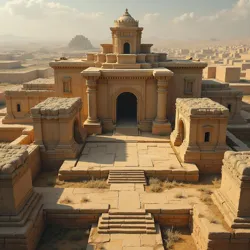Pre-Halafian Period

Archaeological remains of a Pre-Halafian settlement at Karahan Tepe
c. 9000-6100 BCE
Northern Mesopotamia, Anatolia
Archaeological period
Early Neolithic
Göbekli Tepe, Karahan Tepe, Nevali Çori
Megalithomatons, Monumental Architecture
The Pre-Halafian period represents a remarkable phase of human technological and cultural development in Northern Mesopotamia and Anatolia, spanning approximately 9000-6100 BCE. This era is distinguished by unprecedented achievements in mechanical engineering, most notably the construction of Megalithomatons, and the establishment of complex ritual-technological societies that would later give rise to the Halafian civilization.
Archaeological evidence suggests that Pre-Halafian communities possessed sophisticated knowledge of mathematics, astronomy, and mechanical principles that would not be rediscovered until millennia later. Their technological achievements, particularly in the realm of monumental architecture and mechanical automation, challenge traditional understanding of prehistoric human capabilities.
Cultural Characteristics
Social Organization
Pre-Halafian society was characterized by a unique fusion of technological expertise and spiritual practice, centered around the construction and maintenance of Megalithomatons. The society was highly structured, with specialized roles including engineers, astronomers, and the elite class of Stone Priests who operated the massive mechanical constructs. This social stratification was reflected in settlement patterns, with distinct quarters for different specialist groups.
Communities were typically organized around ceremonial centers where Stone Activation Ceremonies were performed, suggesting a society that seamlessly integrated technological achievement with religious observance. The construction and operation of Megalithomatons required unprecedented levels of social cooperation and organizational complexity for their time.
 Reconstructed view of a Pre-Halafian ceremonial center showing integration of astronomical alignments and mechanical systems
Reconstructed view of a Pre-Halafian ceremonial center showing integration of astronomical alignments and mechanical systemsTechnological Innovations
The Pre-Halafian period witnessed the development of sophisticated mechanical principles that would not be replicated until the Classical period. Their understanding of geometric resonance chambers and complex lever systems enabled the creation of massive automated structures. The Karahan Manuscripts suggest that these communities had developed a systematic approach to mechanical engineering, including standardized measurement systems and architectural principles.
Material Culture
Architecture and Engineering
Pre-Halafian architectural achievements extended beyond the famous Megalithomatons to include sophisticated temple complexes and astronomical observatories. The period saw the first systematic use of Geometric Harmonic Design, a sophisticated architectural principle that integrated mathematical ratios with acoustic properties to create structures of remarkable complexity and precision.
Craft Production
While best known for their monumental constructions, Pre-Halafian communities also developed sophisticated crafting techniques. Their stone-working abilities were particularly advanced, employing methods that allowed the precise shaping of massive limestone and granite blocks used in Megalithomaton construction. Evidence suggests they possessed knowledge of advanced metallurgy, though this technology was primarily reserved for specialized tools used in stone-working and mechanical components.
Religious and Ceremonial Practices
Ritual Technology
The Pre-Halafian period represents a unique moment in human history where technological achievement and spiritual practice were inextricably linked. The Stone Activation Ceremonies were complex rituals that combined precise engineering procedures with religious observances, suggesting a worldview that did not distinguish between technological and spiritual power.
Astronomical Alignment
Pre-Halafian sites demonstrate sophisticated understanding of celestial mechanics, with many structures aligned to solar and stellar events. The positioning of Megalithomatons often corresponded to significant astronomical alignments, suggesting their operation may have been coordinated with celestial cycles.
Legacy and Transition
The transition from the Pre-Halafian to the Halafian period remains one of archaeology's most intriguing mysteries. While many technological capabilities appear to have been lost, certain fundamental principles were preserved in modified forms, particularly in architecture and ceramic production. The gradual transformation of the Stone Priest tradition into more conventional religious roles marks a significant shift in how these societies organized themselves.
Archaeological Evidence
Recent excavations at sites like Karahan Tepe have revealed increasing evidence of the sophisticated nature of Pre-Halafian society. The discovery of the Protogeometric Tablets in 2019 has provided new insights into their mathematical understanding and engineering principles, suggesting a level of theoretical knowledge previously thought impossible for Neolithic societies.
Scientific Significance
The study of Pre-Halafian technology has revolutionized our understanding of prehistoric human capabilities. Their achievements in mechanical engineering and architecture have led to the development of new fields such as Archaeo-mechanics and continue to influence modern engineering practices. The period demonstrates that sophisticated technological knowledge could exist and be lost, challenging linear models of human technological development.
See Also
- Stone Activation Ceremonies
- Geometric Resonance Chambers
- Karahan Manuscripts
References
- Institute of Prehistoric Technologies
- Archaeological Records of Northern Mesopotamia
- Journal of Ancient Engineering Studies